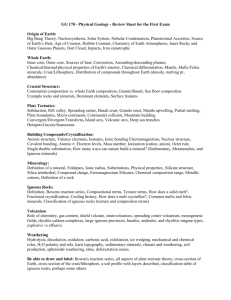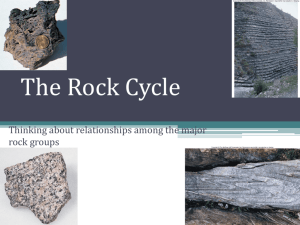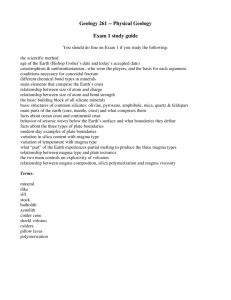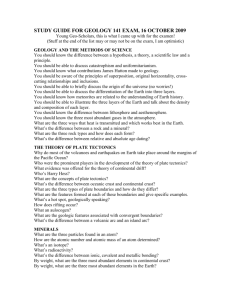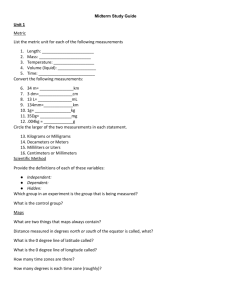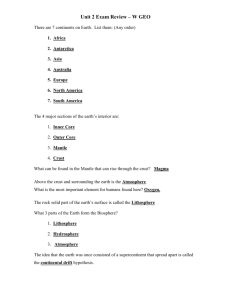Processes of Lithosphere
advertisement
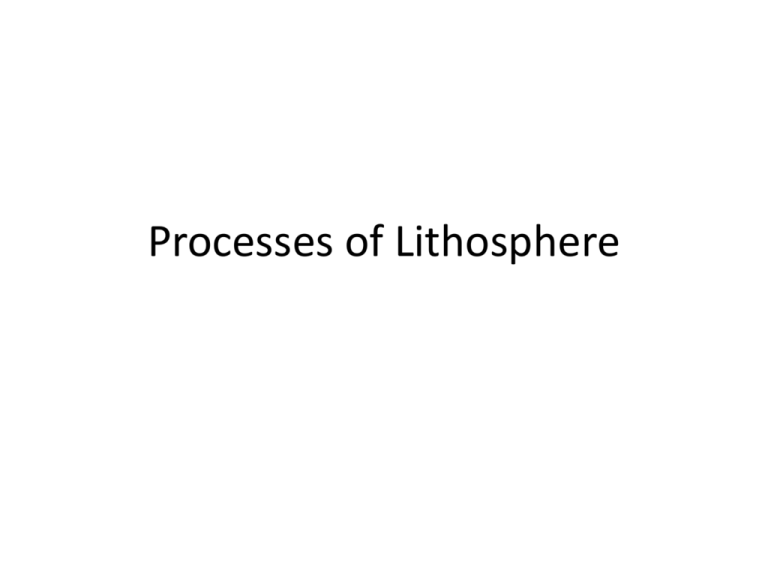
Processes of Lithosphere Lithosphere • Rigid outermost shell of a rocky planet – On earth, comprises the crust and the upper mantle The Rock Cycle Thinking about relationships among the major rock groups Major Rock Groups • Igneous – Formed from a melt (molten rock) – Plutonic (intrusive):slow cooling and crystallization – Volcanic (extrusion): quick cooling at the surface • Sedimentary – Formed at the Earth’s surface • Metamorphic – Changed by pressure, temperature and fluids. 5 Fig. 2.9 MAGMA IGNEOUS Crystallization MAGMA 7 IGNEOUS Plutonic Crystallization MAGMA 8 Volcanic IGNEOUS Plutonic Crystallization MAGMA 9 Weathering Volcanic IGNEOUS Plutonic Crystallization Uplift MAGMA 10 Weathering • Chemical – changing composition (acid rain) • Physical – Breaking apart rocks, moving soils, etc • Soil is result of weathering of rocks and includes weathered particles Weathering SEDIMENT Volcanic IGNEOUS Plutonic Crystallization Uplift MAGMA 12 Weathering SEDIMENT Erosion Transport Deposition Volcanic IGNEOUS SEDIMENTARY Plutonic Crystallization Uplift MAGMA 13 Weathering SEDIMENT Erosion Transport Deposition Volcanic IGNEOUS SEDIMENTARY Plutonic Crystallization Uplift MAGMA 14 Weathering SEDIMENT Erosion Transport Deposition Volcanic IGNEOUS SEDIMENTARY Plutonic Increased P&T METAMORPHIC Crystallization Burial Uplift MAGMA 15 SEDIMENT Weathering Erosion Transport Volcanic Can you see IGNEOUS any shortcuts? Deposition SEDIMENTARY Plutonic Increased P&T METAMORPHIC Crystallization Melting Uplift Burial MAGMA 16 Weathering SEDIMENT Erosion Transport Deposition Volcanic IGNEOUS SEDIMENTARY Plutonic Increased P&T METAMORPHIC Crystallization Melting Uplift Burial MAGMA 17 In Conclusion… • The rock cycle demonstrates the relationships among the three major rock groups • It is powered by the interior heat of the Earth • The energy from the sun • It involves processes on the Earth’s surface as well as the Earth’s interior. The Structure of the Earth and Plate Tectonics Structure of the Earth • The Earth is made up of 3 main layers: – Core – Mantle – Crust Crust Mantle Outer core Inner core The Crust • This is where we live! • The Earth’s crust is made of: Continental Crust - buoyant (less dense than oceanic crust) Oceanic Crust - dense (sinks under continental crust) What is Plate Tectonics? • If you look at a map of the world, you may notice that some of the continents could fit together like pieces of a puzzle. Plate Tectonics • The Earth’s crust is divided into 12 major plates which are moved in various directions. • This plate motion causes them to collide, pull apart, or scrape against each other. • Each type of interaction causes a characteristic set of Earth structures or “tectonic” features. • The word, tectonic, refers to the deformation of the crust as a consequence of plate interaction. World Plates What are tectonic plates made of? • Plates are made of rigid lithosphere. The lithosphere is made up of the crust and the upper part of the mantle. Plate Movement • “Plates” of lithosphere are moved around by the underlying hot mantle convection cells Three types of plate boundary • Divergent • Convergent • Transform Divergent Boundaries • Spreading ridges – As plates move apart new material is erupted to fill the gap Iceland: An example of continental rifting • Iceland has a divergent plate boundary running through its middle Convergent Boundaries • There are three styles of convergent plate boundaries – Continent-continent collision – Continent-oceanic crust collision – Ocean-ocean collision Continent-Continent Collision • Forms mountains, e.g. European Alps, Himalayas Himalayas Continent-Oceanic Crust Collision • Called SUBDUCTION • Area is called the subduction zone Transform Boundaries • Where plates slide past each other Above: View of the San Andreas transform fault Volcanoes and Plate Tectonics… …what’s the connection? Pacific Ring of Fire Volcanism is mostly focused at plate margins Volcanoes are formed by: - Subduction - Rifting - Hotspots Subduction • Form new melt that will rise through the crust to be erupted at the surface Rifting • Form new melt that will rise through the crust to be erupted at the surface Hot Spots • Does not occur along a plate boundary. • Form in the middle of tectonic plates Volcanic Eruptions • Pyroclastic Flow – cloud of ash and debris – Travel at hundreds of mph – Hundreds of degrees Volcanic Eruptions • Lahar – mud flows which are very destructive to landscape Volcanic Eruptions • • • • • “Ash” emitted includes small stones Very dense Chokes life Blots out sunlight Causes wide range temperature drops http://www.youtube.c om/watch?v=UK-hvgP2uY Earthquakes and Plate Tectonics… …what’s the connection? • As with volcanoes, earthquakes are not randomly distributed over the globe Figure showing the distribution of earthquakes around the globe • At the boundaries between plates, friction causes them to stick together. When built up energy causes them to break, earthquakes occur. Where do earthquakes form? Figure showing the tectonic setting of earthquakes Fault Lines • Strike – slip • Reverse • Normal Earthquake Anatomy • Focal point – where the actual earth quake originated underground • Epicenter – location of earth quake on earth’s surface – Above the focal point Earthquake Anatomy • P Waves (primary) – waves which travel fastest, first, and moves through any material – Reach seismographs – Moves land back and forth • S Waves (secondary) – actual surface waves which travel slower and only moves through solids – Moves land up and down http://www.teara.govt.nz/en/interactive/4403 /primary-and-secondary-waves Results.. • • • • Land destruction/alteration Fire (breaking of gas and power lines) Buildings destroyed Tsunami’s Tsunami • “Harbor Wave”

